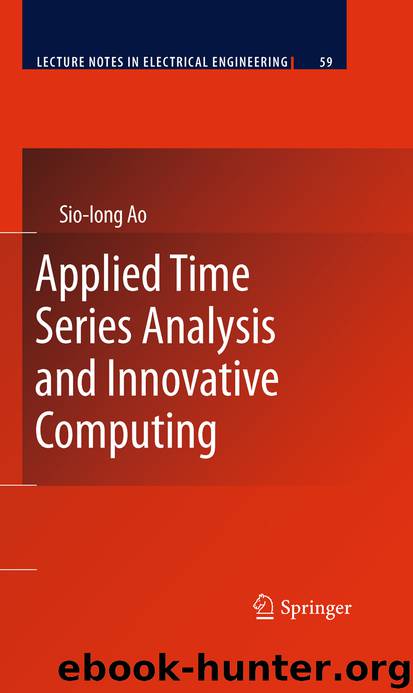Applied Time Series Analysis and Innovative Computing by Sio-Iong Ao

Author:Sio-Iong Ao
Language: eng
Format: epub
Publisher: Springer Netherlands, Dordrecht
5.Make one-step ahead forecasting with the NN models for the first out-of-sample time point.
6.Apply the GA module to assign dynamic weights to the NN models based on the prediction performance of the time point in step 5.
Steps 5 and 6 will then repeat with the forecasting for next out-of-sample time point, and so on, until finishing all out-of-sample time point.
Previous studies have recognized the close relationships between the economic learning models and models of evolutionary computation. The objective of our framework is to develop a system that can take over the task of the model selection process. The system has the capability to learn which model should be employed for different sub-periods. The goal of the GA is to let the strategy with higher payoff to remain while the ones with lower payoff more likely to disappear. This methodology is suitable for our evolutionary purpose. We can image that there exist many prediction models. The evolutionary process comes into play to let the model with better prediction to survive more likely than the ones with poor records. The objective function is defined to minimize the sum of absolute errors of the predictions.
The methodology can work with inputs data like indices of the regional countries. Input data, like the trade volume, economic growth rate and currency exchange rate, etc., can also be tested by the VAR analysis. For the input variables with the lowest significance level, they will be used as the input variables for the neural network. The performance of the predictions made by the neural network with these input variables is time-dependent and unstable. In some sub-periods, some input variables may be fitter for the prediction, while, in other sub-periods, they may be poorer in fact. These neural network prediction models with different inputs can be regarded as experts of different opinions of the relevant input factors. Their predictions may vary with time, as said. The selection and evaluation of these predictors can be made in the evolutionary cycle. Experts with higher forecasting accuracy in each cycle are going to weigh more heavily in the coming round.
In the following two business applications, we will illustrate the details of how to implement this cybernetic approach to quantify the cross-market dynamics and to make accurate forecasting.
Download
This site does not store any files on its server. We only index and link to content provided by other sites. Please contact the content providers to delete copyright contents if any and email us, we'll remove relevant links or contents immediately.
Deep Learning with Python by François Chollet(12569)
Hello! Python by Anthony Briggs(9914)
OCA Java SE 8 Programmer I Certification Guide by Mala Gupta(9795)
The Mikado Method by Ola Ellnestam Daniel Brolund(9777)
Dependency Injection in .NET by Mark Seemann(9337)
Algorithms of the Intelligent Web by Haralambos Marmanis;Dmitry Babenko(8296)
Test-Driven iOS Development with Swift 4 by Dominik Hauser(7763)
Grails in Action by Glen Smith Peter Ledbrook(7696)
The Well-Grounded Java Developer by Benjamin J. Evans Martijn Verburg(7557)
Becoming a Dynamics 365 Finance and Supply Chain Solution Architect by Brent Dawson(7063)
Microservices with Go by Alexander Shuiskov(6824)
Practical Design Patterns for Java Developers by Miroslav Wengner(6741)
Test Automation Engineering Handbook by Manikandan Sambamurthy(6685)
Secrets of the JavaScript Ninja by John Resig Bear Bibeault(6413)
Angular Projects - Third Edition by Aristeidis Bampakos(6089)
The Art of Crafting User Stories by The Art of Crafting User Stories(5617)
NetSuite for Consultants - Second Edition by Peter Ries(5555)
Demystifying Cryptography with OpenSSL 3.0 by Alexei Khlebnikov(5360)
Kotlin in Action by Dmitry Jemerov(5062)
